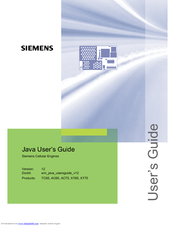Siemens AC65 Manuals
Manuals and User Guides for Siemens AC65. We have 1 Siemens AC65 manual available for free PDF download: User Manual
Siemens AC65 User Manual (123 pages)
Siemens Cell Phone Accessories User Manual
Brand: Siemens
|
Category: Cell Phone Accessories
|
Size: 6.35 MB
Table of Contents
Advertisement
Advertisement
